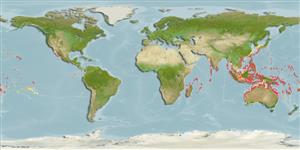>
Eupercaria/misc (Various families in series Eupercaria) >
Scaridae (Parrotfishes) > Scarinae
Etymology: Cetoscarus: Greek, ketos = a marine monster, whale + Greek, skaros = a fish cited by ancient writers; a parrot fish (Ref. 45335); ocellatus: Name based on the juvenile phase (Ref. 54980).
More on author: Valenciennes.
Environment: milieu / climate zone / depth range / distribution range
экология
морской ассоциированный с рифами; пределы глубины 0 - 30 m (Ref. 90102). Tropical
Indo-Pacific: from Somalia to South Africa, eastwards to the Tuamotos including eastern Australia and Middleton Reef; north to southern Japan; south to western Australia.
Length at first maturity / Size / Вес / Возраст
Maturity: Lm 30.0 range ? - ? cm
Max length : 80.0 cm SL самец/пол неопределен; (Ref. 54980)
Краткое описание
морфология | морфометрия
This species is characterized by the following: 14-15 (usually 14) pectoral rays; 5-7 (usually 6) median predorsal scales; 3 rows of scales on cheek, the lower one with 3-7 scales; nodular outer surface of dental plates (vs. smooth on Chlorurus, Hipposcarus and Scarus); conical teeth absent on side of dental plates; lips largely covering dental plates; long snout 1.8-2.2 in HL; juveniles with rounded caudal fin, emarginate in adults. Initial phase with head purplish to reddish brown, finely spotted with black ventrally; body with a broad, pale yellowish zone dorsally, bluish gray below; scales rimmed and spotted with black; median fins brownish red and caudal with a whitish crescent posteriorly. Terminal males green, scales rimmed with pink, head and anterior body with numerous small pink spots except below an orange line from corner of the mouth to pectoral base and across upper abdomen, where solid green with broad, pink, longitudinal ventral band; juveniles white with a broad, dark-edged orange bar covering head except snout and chin, a large, orange-rimmed black spot anteriorly in dorsal fin, and a broad, submarginal orange band in caudal fin (Ref. 54980).
Inhabits seaward reefs and clear lagoons (Ref. 1602), at depths of 1-30 m. Occurs in groups of females with one male (Ref. 90102) form harems; while juveniles are usually solitary (Ref. 9710). Males are territorial. Goes to several changes during growth and very large females change sex to the brightly colored male. Small juveniles usually in dense coral and algae habitats (Ref. 48636). Feeds on benthic algae (Ref. 89972). Minimum depth reported taken from Ref. 128797.
Life cycle and mating behavior
половая зрелость | размножение | нерест | икра | Fecundity | личинки
Oviparous, distinct pairing during breeding (Ref. 205).
Randall, J.E., 2005. Reef and shore fishes of the South Pacific. New Caledonia to Tahiti and the Pitcairn Islands. University of Hawaii Press, Honolulu, Hawaii. 720 p. (Ref. 54980)
Статус Красного Списка МСОП (Ref. 130435)
Угроза для людей
Harmless
Использование человеком
дополнительная информация
ссылкиаквакультура (рыбоводство)особенности рыбоводствастепень растяжениягенетикаElectrophoresesнаследуемостьболезниобработкаNutrientsMass conversion
соавторыизображенияStamps, Coins Misc.звукиCiguateraскоростьтип плаванияжаберная областьOtolithsмозгзрение
инструменты
Специальные отчеты
Скачать в формате XML
ресурсы в Интернет
Estimates based on models
Preferred temperature (Ref.
123201): 24.6 - 29.3, mean 28.2 °C (based on 2269 cells).
Phylogenetic diversity index (Ref.
82804): PD
50 = 0.7500 [Uniqueness, from 0.5 = low to 2.0 = high].
Bayesian length-weight: a=0.01479 (0.00838 - 0.02612), b=3.02 (2.87 - 3.17), in cm total length, based on LWR estimates for this species & (Sub)family-body (Ref.
93245).
устойчивость к внешним воздействиям (Ref.
120179): средний (среднего размера), минимальное время удвоения популяции 1.4-4.4 года (Preliminary K or Fecundity.).
Fishing Vulnerability (Ref.
59153): High vulnerability (59 of 100).
Nutrients (Ref.
124155): Calcium = 27.2 [14.7, 51.5] mg/100g; Iron = 0.522 [0.281, 0.936] mg/100g; Protein = 18.5 [16.4, 20.3] %; Omega3 = 0.0848 [, ] g/100g; Selenium = 37.5 [18.7, 72.4] μg/100g; VitaminA = 47.5 [12.3, 167.8] μg/100g; Zinc = 1.5 [1.0, 2.4] mg/100g (wet weight);
